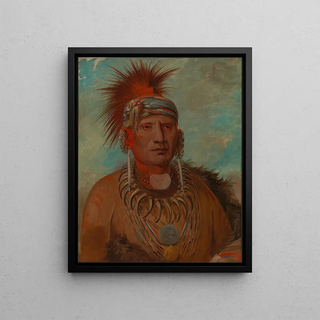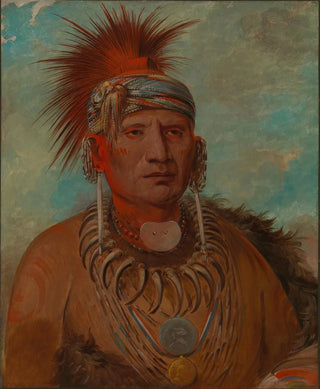Art print | Neu-mon-ya Walking Rain War Chief - George Catlin


View from behind

Frame (optional)
In the fascinating world of art, some works transcend their era to become timeless witnesses of human culture. The art print Neu-mon-ya Walking Rain Chief of War - George Catlin is one of those creations that capture not only the eye but also the spirit. This piece, created by George Catlin, a pioneer of Native American painting, evokes with rare intensity the life and traditions of Indigenous peoples of North America. Through the piercing gaze of this chief of war, the artist transports us to a world where nature and warrior spirit coexist, revealing an emotional depth that invites reflection.
Style and uniqueness of the work
Catlin's style is distinguished by its ability to blend realism and romanticism, offering a representation that is both faithful and poetic of the subjects he immortalizes. In Neu-mon-ya Walking Rain Chief of War, vibrant colors and meticulous details illustrate not only the imposing stature of the chief but also the soul of a people in harmony with their environment. The patterns and textures of traditional clothing, as well as the determined expression of the character, testify to a deep respect for Native American culture. The dynamic composition of the work, where the chief seems almost in motion, evokes a sense of vitality and energy, immersing the viewer in an engaging atmosphere. Catlin thus succeeds in capturing the very essence of his subject while offering an artistic vision that goes beyond simple representation.
The artist and his influence
George Catlin, born in 1796, dedicated a large part of his life to documenting the lifestyles of Native American tribes, becoming one of the first artists to introduce these cultures to the Western world. His work is the result of a passionate commitment to preserving the memory of the peoples he encountered during his travels across America. Catlin was able to combine his artistic talent with a deep desire to raise public awareness of the often little-known realities of Indigenous populations, thus becoming a pioneer in the field of visual anthropology. His influence is felt not only in the art world but also in cultural studies

Matte finish

View from behind

Frame (optional)
In the fascinating world of art, some works transcend their era to become timeless witnesses of human culture. The art print Neu-mon-ya Walking Rain Chief of War - George Catlin is one of those creations that capture not only the eye but also the spirit. This piece, created by George Catlin, a pioneer of Native American painting, evokes with rare intensity the life and traditions of Indigenous peoples of North America. Through the piercing gaze of this chief of war, the artist transports us to a world where nature and warrior spirit coexist, revealing an emotional depth that invites reflection.
Style and uniqueness of the work
Catlin's style is distinguished by its ability to blend realism and romanticism, offering a representation that is both faithful and poetic of the subjects he immortalizes. In Neu-mon-ya Walking Rain Chief of War, vibrant colors and meticulous details illustrate not only the imposing stature of the chief but also the soul of a people in harmony with their environment. The patterns and textures of traditional clothing, as well as the determined expression of the character, testify to a deep respect for Native American culture. The dynamic composition of the work, where the chief seems almost in motion, evokes a sense of vitality and energy, immersing the viewer in an engaging atmosphere. Catlin thus succeeds in capturing the very essence of his subject while offering an artistic vision that goes beyond simple representation.
The artist and his influence
George Catlin, born in 1796, dedicated a large part of his life to documenting the lifestyles of Native American tribes, becoming one of the first artists to introduce these cultures to the Western world. His work is the result of a passionate commitment to preserving the memory of the peoples he encountered during his travels across America. Catlin was able to combine his artistic talent with a deep desire to raise public awareness of the often little-known realities of Indigenous populations, thus becoming a pioneer in the field of visual anthropology. His influence is felt not only in the art world but also in cultural studies






